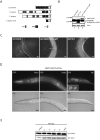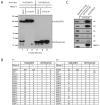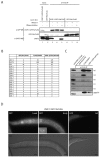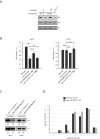The ribonucleotidyl transferase USIP-1 acts with SART3 to promote U6 snRNA recycling
- PMID: 25753661
- PMCID: PMC4381082
- DOI: 10.1093/nar/gkv196
The ribonucleotidyl transferase USIP-1 acts with SART3 to promote U6 snRNA recycling
Abstract
The spliceosome is a large molecular machine that serves to remove the intervening sequences that are present in most eukaryotic pre-mRNAs. At its core are five small nuclear ribonucleoprotein complexes, the U1, U2, U4, U5 and U6 snRNPs, which undergo dynamic rearrangements during splicing. Their reutilization for subsequent rounds of splicing requires reversion to their original configurations, but little is known about this process. Here, we show that ZK863.4/USIP-1 (U Six snRNA-Interacting Protein-1) is a ribonucleotidyl transferase that promotes accumulation of the Caenorhabditis elegans U6 snRNA. Endogenous USIP-1-U6 snRNA complexes lack the Lsm proteins that constitute the protein core of the U6 snRNP, but contain the U6 snRNP recycling factor SART3/B0035.12. Furthermore, co-immunoprecipitation experiments suggest that SART3 but not USIP-1 occurs also in a separate complex containing both the U4 and U6 snRNPs. Based on this evidence, genetic interaction between usip-1 and sart-3, and the apparent dissociation of Lsm proteins from the U6 snRNA during spliceosome activation, we propose that USIP-1 functions upstream of SART3 to promote U6 snRNA recycling.
© The Author(s) 2015. Published by Oxford University Press on behalf of Nucleic Acids Research.
Figures







Similar articles
-
SART3 associates with a post-splicing complex.J Cell Sci. 2023 Jan 15;136(2):jcs260380. doi: 10.1242/jcs.260380. Epub 2023 Jan 23. J Cell Sci. 2023. PMID: 36620952
-
Recycling of the U12-type spliceosome requires p110, a component of the U6atac snRNP.Mol Cell Biol. 2004 Feb;24(4):1700-8. doi: 10.1128/MCB.24.4.1700-1708.2004. Mol Cell Biol. 2004. PMID: 14749385 Free PMC article.
-
A doughnut-shaped heteromer of human Sm-like proteins binds to the 3'-end of U6 snRNA, thereby facilitating U4/U6 duplex formation in vitro.EMBO J. 1999 Oct 15;18(20):5789-802. doi: 10.1093/emboj/18.20.5789. EMBO J. 1999. PMID: 10523320 Free PMC article.
-
Trans-splicing and operons.WormBook. 2005 Jun 25:1-9. doi: 10.1895/wormbook.1.5.1. WormBook. 2005. PMID: 18050426 Review.
-
Trans-splicing and operons in C. elegans.WormBook. 2012 Nov 20:1-11. doi: 10.1895/wormbook.1.5.2. WormBook. 2012. PMID: 23175478 Free PMC article. Review.
Cited by
-
Cajal bodies and snRNPs - friends with benefits.RNA Biol. 2017 Jun 3;14(6):671-679. doi: 10.1080/15476286.2016.1231359. Epub 2016 Sep 14. RNA Biol. 2017. PMID: 27627834 Free PMC article. Review.
-
Functions and mechanisms of RNA tailing by metazoan terminal nucleotidyltransferases.Wiley Interdiscip Rev RNA. 2021 Mar;12(2):e1622. doi: 10.1002/wrna.1622. Epub 2020 Jul 22. Wiley Interdiscip Rev RNA. 2021. PMID: 33145994 Free PMC article. Review.
-
Serrate-Associated Protein 1, a splicing-related protein, promotes miRNA biogenesis in Arabidopsis.New Phytol. 2021 Dec;232(5):1959-1973. doi: 10.1111/nph.17691. Epub 2021 Sep 16. New Phytol. 2021. PMID: 34449907 Free PMC article.
-
Combined flow cytometry and high-throughput image analysis for the study of essential genes in Caenorhabditis elegans.BMC Biol. 2018 Mar 29;16(1):36. doi: 10.1186/s12915-018-0496-5. BMC Biol. 2018. PMID: 29598825 Free PMC article.
-
Revealing the hidden RBP-RNA interactions with RNA modification enzyme-based strategies.Wiley Interdiscip Rev RNA. 2024 May-Jun;15(3):e1863. doi: 10.1002/wrna.1863. Wiley Interdiscip Rev RNA. 2024. PMID: 39392204 Free PMC article. Review.
References
-
- Wahl M.C., Will C.L., Luhrmann R. The spliceosome: design principles of a dynamic RNP machine. Cell. 2009;136:701–718. - PubMed
-
- Tharun S. Roles of eukaryotic Lsm proteins in the regulation of mRNA function. Int. Rev. Cell. Mol. Biol. 2009;272:149–189. - PubMed
-
- Staley J.P., Guthrie C. Mechanical devices of the spliceosome: motors, clocks, springs, and things. Cell. 1998;92:315–326. - PubMed
-
- Vijayraghavan U., Company M., Abelson J. Isolation and characterization of pre-mRNA splicing mutants of Saccharomyces cerevisiae. Genes Dev. 1989;3:1206–1216. - PubMed
-
- Shannon K.W., Guthrie C. Suppressors of a U4 snRNA mutation define a novel U6 snRNP protein with RNA-binding motifs. Genes Dev. 1991;5:773–785. - PubMed
Publication types
MeSH terms
Substances
LinkOut - more resources
Full Text Sources
Other Literature Sources
Molecular Biology Databases
Research Materials

